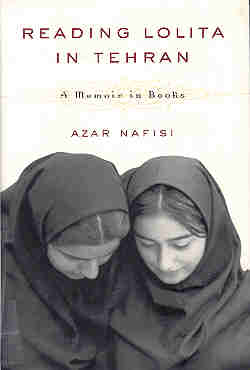Reading Lolita in Tehran
Azar Nafisi

“In the fall of 1995, after resigning from my last academic post, I decided to indulge myself and fulfill a dream. I chose seven of my best and most committed students and invited them to come to my home every Thursday morning to discuss literature. They were all women – to teach a mixed class in the privacy of my home was too risky, even if we were discussing harmless works of fiction. One persistent male student, although barred from our class, insisted on his rights. So he, Nima, read the assigned material, and on special days he would come to my house to talk about the books we were reading.”
So opens the work under consideration for this month: Reading Lolita in Tehran. Subtitled “A Memoir in Books”, it's the story of writer Azar Nafisi's dream and of the nightmare that made it come true. Flashing back to the early days of the Iranian revolution when Nafisi first began teaching at the University of Tehran, her account tells of the frenetic days when the students took control of the university, expelled faculty members, and purged the curriculum. The heart of Nafisi's book, though, is the memoir of the women in the reading group she formed and held for two years before she left Iran in 1997.
“I have the two photographs in front of me now. In the first there are seven women, standing against a white wall. They are, according to the law of the land, dressed in black robes and head scarves, covered except for the oval of their faces and their hands. In the second photograph the same group, in the same position, stands against the same wall. Only they have taken off their coverings. Splashes of color separate one from the next. Each has become distinct through the color and style of her clothes, the color and length of her hair; not even the two who are still wearing head scarves look the same....
For nearly two years, almost every Thursday morning, rain or shine, they came to my house, and almost every time, I could not get over the shock of seeing them shed their mandatory veils and robes and burst into color. When my students came into that room, they took off more than their scarves and robes. Gradually, each one gained an outline and a shape, becoming her own inimitable self. Our world in that living room with its window framing my beloved Elburz Mountains became our sanctuary, our self-contained universe, mocking the reality of black-scarved, timid faces in the city that sprawled below.”
Azar Nafisi's luminous prose paints a fascinating portrait of the Iran-Iraq war viewed from Tehran and gives the reader a rare glimpse, from the inside, of women's lives in revolutionary Iran. It is a work of poetic beauty and great passion, written in a startlingly original voice. Be sure to read all about it.
All Rights Reserved.